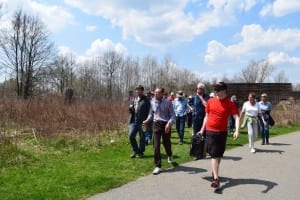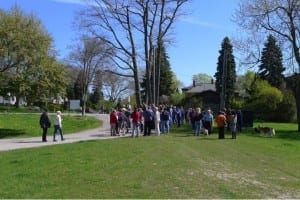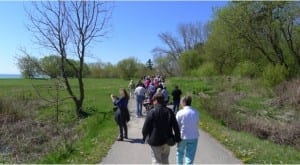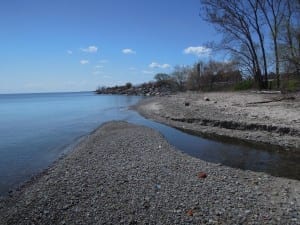May 28, 2016 Small Arms Jane’s Walk. What is a Jane’s Walk? I don’t know. That’s what I like about Jane’s Walk.

Walking south along Waterfront Trail toward Lake Ontario shoreline, from Small Arms Building, during May 3, 2105 Small Arms Jane’s Walk led by City of Mississauga Ward One Councillor Jim Tovey (second from left, holding coffee mug). Wooden baffles at Long Branch Rifle Ranges are visible in background. Jaan Pill photo
What is a Jane’s Walk?
A May 1, 2016 message from Jane’s Walk reads:
“Every single one of us has a story, an opinion, a question, or a dream about where they live, work, and play. And every Jane’s Walk is a catalyst for doing something about it.”
I’ve been involved with leading and/or organizing Jane’s walks for five years, in Etobicoke and Mississauga. As I’ve mentioned at a previous post, I don’t know what Jane’s Walk is and that’s the way I like it.
Open-endedness
I like the open-ended quality of communications from Jane’s Walk. There isn’t a prescription that says, “This is what a Jane’s Walk is.”

Long Branch Jane’s Walk, May 6, 2012. We began the walk at Marie Curtis Park at the mouth of Etobicoke Creek. Peter Foley photo
Is it a walking conversation or a walking lecture?
Depending on the organizers, and the leader(s), a Jane’s walk can have elements that come across primarily as a conversation, or primarily as a lecture, or as something in between the two. At times, the lecture format is what works the best. In walks that I’ve co-led with Mike James, over time we got really proficient at doing all the little things that ensure that a walk turns into a great conversation.
That’s my favourite format. I recall one year, when we had a walk on a Saturday and a Sunday (as we often did, from year to year), when some of the walkers, who had attended on the Saturday, made a point of also attending on the Sunday. They explained that they wanted to join the walk the next day, because they had so much enjoyed a walk where so many people join in the conversation.

Walking west along the Waterfront Trail during May 6, 2012 Jane’s Walk in Long Branch. The walkers are heading in the direction of Applewood Creek in Mississauga. The trail that you see is where the southern branch of Etobicoke Creek used to flow – in a direction parallel to the trail, and south of it – on its way to Lake Ontario during the Country Cottage era. Mike Foley photo
That is very distinct, in my experience, from a walk where the leader or leaders are the authorities, with some specialized knowledge about a given subject, and for whom the role of professor or lecturer or expert comes easily and readily, and who would not likely see themselves in a situation where the entire event is an extended conversation, in which the leader(s) may end up doing less talking, over the course of the walk, than some of the regular walk participants.
I no longer lead walks, and what format a leader takes, for a walk that I help to organize, is up to the leader. I’m happy to just be there, and to take along a portable amplifier, so that if the group is large, all can hear whichever person happens to be at the microphone, at a given point during the walk.
Wheelchair for May 28, 2015 Small Arms Jane’s Walk, which starts at 1:00 pm that day at the front lawn of the Small Arms Building at Dixie Road and Lakeshore Road East
This year for the May 28, 2016 Small Arms Jane’s Walk in Mississauga, which City of Mississauga Councillor Jim Tovey will be leading, I’ll be using a wheelchair, which will serve as a great way for me to carry a portable amplifier from one stop to another.

Applewood Creek at Mississauga-Toronto border at shoreline of Lake Ontario. The border is located just to the west of the creek. Jaan Pill photo
One year I tried a children’s wagon for this task but it shook up my audio recorder pretty bad, so the extent that the recordings would not play back, when I tried to review them the next day.
I had thought of buying or renting a garden cart with a good suspension system, or a cart of the kind used on movie sets to move equipment around, and for dolly shots, but then I realized that borrowing a wheelchair is the perfect option for me.
Social Innovation
I don’t know what a Jane’s Walk is. Nor do I know what Social Innovation is. I think Social Innovation may be hype for keeping things as they are, but giving the appearance that a person is contributing to change in the world.
In terms of my own experience, Jane’s Walk is a great way for people to network. I’ve done some great networking through my work in organizing and taking part in such walks. Jane’s Walk is also a great way, in my experience, to ponder what Jane Jacobs was about, and to think of the relevance that her work has, or does not have, in the context of the present moment.
Dark Age Ahead (2004)
My current task, among others, is to read Dark Age Ahead (2004) by Jane Jacobs, who was not an academic. That said, she was very much involved with the intellectual currents of her time and had a significant impact on them. Among other things, she contributed strongly to the intellectual currents of the 1960s and 1970s.
Her thoughts continue to reverberate, as can be noted in a May 4, 2016 Citylab article entitled: “Even Late in Her Career, Jane Jacobs Made Predictions That Are Coming True Today: Her widely panned last book, Dark Age Ahead, cautioned against social and economic decay and the rise of demagogues like Donald Trump.”
I am also reading a good companion piece, to the above-noted book, namely The End of Alchemy: Money, Banking, and the Future of the Global Economy (2016) by Melvyn King, former governor of the Bank of England.
What are the implications, if any, of the fact that the New York neighbourhood that Jane Jacobs saved from destruction is now out of reach of middle-class homebuyers?
A previous post about Jane Jacobs is entitled: Reconsidering Jane Jacobs (2011) offers an overview of her work and legacy.
Among other things, Reconsidering Jane Jacobs (2011) notes that Jane Jacobs saved the local New York neighbourhood where she lived, but now the neighbourhood has been gentrified to the extent that people with middle-class incomes can’t afford to live there. What the significance of that fact is, or is not, warrants analysis and discussion.
Many books about Jane Jacobs are available at the Toronto Public Library; such studies are well worth reading for any person who has an interest in Jane’s Walk and the legacy of Jane Jacobs.
Update
A May 26, 2016 London School of Economics article is entitled: “From the Third Way to the Big Society: the rise and fall of social capital.”

Leave a Reply
Want to join the discussion?Feel free to contribute!